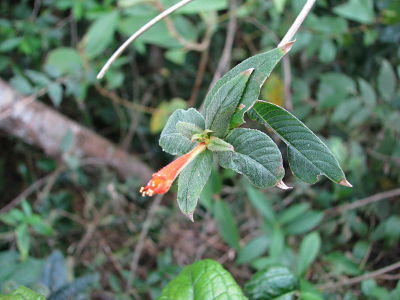Here’s a camera that went to Africa and recorded fine details in the environment that the retinas of early humans had to distinguish. A friend and retina expert most generously lent it to me while he and his wife are in the US.
It’s an honor to use this camera.

It’s a Nikon D70 and I’ve been a little shy about getting started with it, have mostly been shooting in autofocus and with the standard lens. Getting acquainted with the heft of the instrument.
Today I decided to go for it and try the macro* lens. Still using autofocus, still adjusting to the heft, but trying, just to see what happens.
Solanum sp.
Starting at the time of last year’s bloom, I have been trying to get a decent shot of this species of Solanum. Here’s the best I’ve been able to do with my Canon point and shoot so far.

This morning, with all the wrong conditions – sun bright in the sky, a breeze blowing – after very few shots, here’s what I got.

I don’t know if you can see why I’m excited about the difference, but I am, and I’m encouraged that I’ll be able to get a really good one of this flower before the blooming season is over this year.
Cuphea sp.
These little firecrackers, as I call them, have eluded me for at least five years. I’ve tried on an off over that time, but they dangle in the breeze all the time, they’re small, and, well, here’s the best I could do before today.

Even today, my Cuphea wouldn’t quite stay in focus. This lovely Nikon has several focus areas, and I’m still trying to get a grip on how to tell it which one I want. For now, Nikon is making these decisions, and today it decided the bugs on the Cuphea were far more interesting than the flower itself.
So here’s my best Cuphea today:

And here’s Nikon’s favorite:

With another view, on another Cuphea, of the same king of bug:

So, while waiting for some delectable photos to come here at Accidental Botanist, feast on the current Berry Go Round at the irrepressible Plants are the Strangest People. It reminds me of a four-hour lunch I had in Italy way back when, and I’ll certainly be spending much of the rest of the month devouring all those intriguing posts.
Update, July 6, 2011: Ted MacRae of Beetles in the Bush has provided a likely identification for this bug. Here’s what he says:
The insects look like leaf-footed bugs (family Coreidae) in the genus Hypselonotus. The only species in nearby Costa Rica with entirely black legs is H. concinnus, so this could be that species.
You’ll see the comment below.
—-
*Nikon calls this lens micro. Its full name is AF Micro-Nikkor 60mm f/2.8D.
- Sun Worshippers for the Garden… (greenflbroker.com)
- Flowers (bookmouse.wordpress.com)













